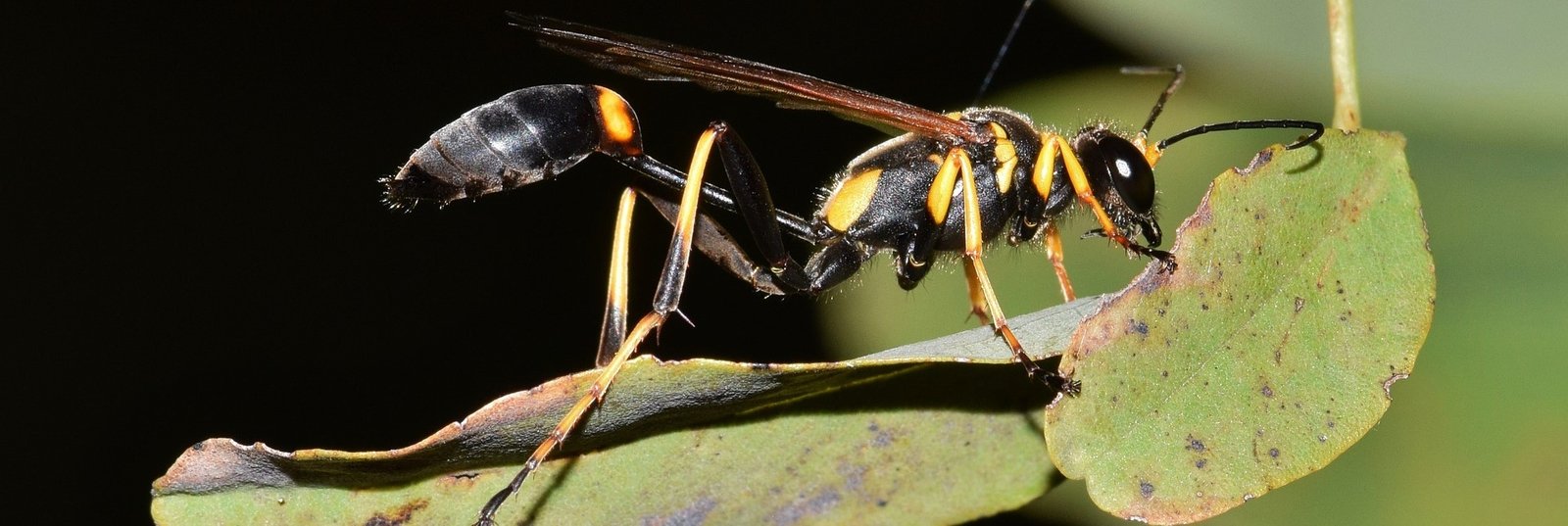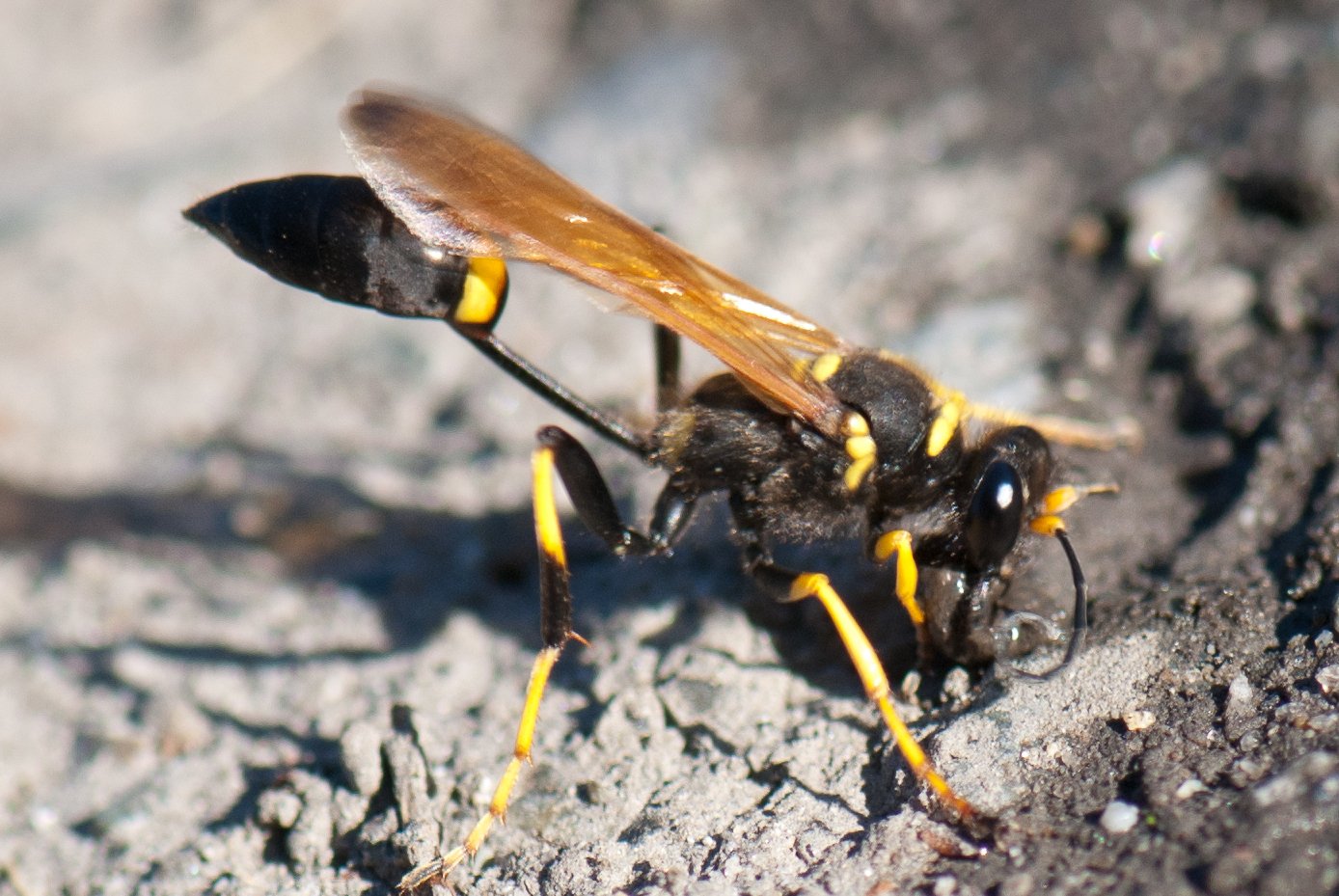Mud Daubers: Sceliphron, Trypoxylon, Chalybion

Mud Dauber Description
Mud daubers are wasps with thin threadlike waists. These solitary wasps belong to a few similar species groups, but because they all construct their nests out of mud, we call them ‘mud daubers.’ By body coloration and by the distinctive nest architecture, the various species can be identified.
Learn More: Wasps, Bees, & Hornets
Species Of Mud Daubers
Black & Yellow Mud Dauber Sceliphron caementarium
- Covered in black and yellow stripes
- Nest cells are constructed side by side
- Rounded nest and is the size of a lemon
Pipe Organ Mud Dauber Trypoxylon politum
- Black colored body, white legs, and blue wings
- Nest cells are parallel to one another
- Nest looks like a pipe organ
Blue Mud Wasp Chalybion californicum
- Metallic blue body-color
- Reuses nests built by other insect species
- Carries water that is used to reshape older mud nests 1Go To Source nature.mdc.mo.gov -“MUD DAUBERS”
Mud Dauber Behavior

Female mud daubers are construct nest from mud, and this is what gives this wasp its name. Mud is rolled into a ball, carried with the wasp’s mandibles to the nest, and molded into place.
Three distinct wasps are practicing this behavior. The black and yellow mud dauber creates a series of cylindrical cells, eventually covered with mud to form a smooth mud nest about a fist’s size. A more robust, black species, the organ-pipe mud dauber, constructs cylindrical tubes resembling pipe-organ pipes. A beautiful metallic-blue wasp with blue wings is the third species. This one does not construct its own mud nest but uses the black, and yellow mud dauber’s abandoned nests instead.
After the mud nest is completed, the female captures several insects or spiders to supply the cells. Before being put into the nest, the prey is stung and paralyzed. A single egg within each cell is deposited on the prey, and the cell is sealed with mud. She departs and does not return after the wasp has completed a series of cells. The larvae left on the spare prey items will hatch, and the eggs will feed on those items. 2Go To Source hortnews.extension.iastate.edu -“Mud Dauber Wasp”
Reproduction Cycle Of Mud Daubers
The female mud dauber will deposit a single egg on the abdomen of one of the first spiders she places in a cell. The egg, measuring between 0.3 and 0.4 millimeters, is cream or white and curved in form.
After 1 1/2 to 3 1/2 days, the larva is enclosed by the egg. The larva color begins as cream and, as it grows, becomes brighter yellow. Depending on the temperature, the larva consumes all the provisioned spider prey within 1 to 3 weeks.
In the winter, the pre-pupal phase will enter diapause until the temperature rises. The pupal case, or cocoon, is spun within the nest cell and is reddish-brown, thin, and oblong-shaped. After emergence, the adult will live for three to six weeks. The Multivoltine Sceliphron Caementarium is (multiple generations per year). 3Go To Source entnemdept.ufl.edu -“black and yellow mud dauber”
Mud Daubers Range & Distribution
Mud dauber wasp species can be found in the United States, Canada, South Africa, Central America, and the West Indies.
Diet Of The Mud Dauber

Both sexes often drink flower nectar, but they stock their nests with spiders, which serve their offspring as food. They prefer specific kinds of spiders and spiders’ specific sizes to their larders, like connoisseurs. Mud daubers will stockpile smaller spiders in the nest because they can fit smaller spiders rather than large spiders.
Black and yellow mud daubers’ typical prey include crab spiders, orb weavers, and some jumping spiders. In and around vegetation, they generally find them.
Blue mud daubers and their relatives prefer immature black widow spiders. They hunt for these spiders in dry, rocky areas.
Pipe-organ mud daubers usually stock their nests with different kinds of orb weavers, but other types of spiders are also included in their diets.
Mud Dauber Predators
Mud daubers and their nests have numerous parasites and parasitoids. Many wasps and flies parasitize immature stages of this wasp by killing and consuming the immature mud dauber. Parasites may also consume spider prey in the nest.
Perhaps the most significant natural enemy of Sceliphron caementarium is the parasitoid wasp Melittobia. It is also reported that bee flies, flesh flies, cuckoo wasps, and velvet ants use Sceliphron caementarium as a host.
Mud Daubers And Human Interaction
Mud daubers rarely sting people and use their stingers primarily to paralyze spiders. These wasps are non-aggressive, and their nests do not defend them. The insects will flee, but if felt individually threatened, they will attack.
It is out of self-defense if they do sting, and the pain is comparable to a bee sting. Problems occur when people are allergic to the venom produced from a dauber sting.
Sources:
- “Mud Daubers.” MDC Discover Nature, State Of Missouri, nature.mdc.mo.gov/discover-nature/field-guide/mud-daubers. Accessed 10 Feb. 2021.
- “Mud Dauber Wasp | Horticulture and Home Pest News.” Iowa State University Extension And Outreach, ISU Extension and Outreach, hortnews.extension.iastate.edu/mud-dauber-wasp. Accessed 10 Feb. 2021.
- Powell, Erin, and Taylor Taylor. “Black and Yellow Mud Dauber – Sceliphron Caementarium.” University Of Florida, University of Florida, May 2016, entnemdept.ufl.edu/creatures/MISC/WASPS/Sceliphron_caementarium.htm.
